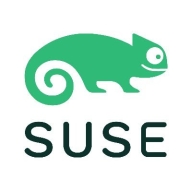

SUSE Linux Enterprise and openSUSE Leap compete in the enterprise Linux solutions category. SUSE Linux Enterprise holds the upper hand due to its robust support for SAP and Oracle workloads, making it particularly suitable for enterprises.
Features: SUSE Linux Enterprise is known for its high stability and integrated management tools like YaST, which simplify server administration. It offers strong security features and a seamless upgrade process. openSUSE Leap provides efficient management tools and the BTRFS file system for snapshots, appealing to users prioritizing server management.
Room for Improvement: SUSE Linux Enterprise users suggest simpler integration with cloud systems and enhanced documentation and support for global security standards, along with a more competitive pricing model. openSUSE Leap could benefit from better integration with Windows and third-party applications and more robust documentation for hardware configurations.
Ease of Deployment and Customer Service: SUSE Linux Enterprise is versatile across deployment environments like public, hybrid, and on-premises clouds, with strong technical support. However, its SUSE-specific tools and system registration may present a learning curve. openSUSE Leap focuses on on-premises deployment, relying on community forums for support, which is often sufficient for troubleshooting.
Pricing and ROI: SUSE Linux Enterprise has a structured pricing model, providing paid support which results in higher costs. Users report a better ROI, especially for SAP deployments, and value its subscription-based support. openSUSE Leap, being open-source and free, offers a cost-effective solution without enterprise-grade support needs.
| Product | Market Share (%) |
|---|---|
| SUSE Linux Enterprise | 6.2% |
| openSUSE Leap | 6.2% |
| Other | 87.6% |

| Company Size | Count |
|---|---|
| Small Business | 2 |
| Midsize Enterprise | 1 |
| Large Enterprise | 4 |
| Company Size | Count |
|---|---|
| Small Business | 8 |
| Midsize Enterprise | 11 |
| Large Enterprise | 21 |
openSUSE Leap is a brand new way of building openSUSE and is new type of hybrid Linux distribution. Leap uses source from SUSE Linux Enterprise (SLE), which gives Leap a level of stability unmatched by other Linux distributions, and combines that with community developments to give users, developers and sysadmins the best stable Linux experience available. Contributor and enterprise efforts for Leap bridge a gap between matured packages and newer packages found in openSUSE’s other distribution Tumbleweed.
SUSE Linux Enterprise offers features like YaST for server management, seamless integration with Oracle and SAP, and a robust security setup. Renowned for stability, it efficiently supports workstations, SAP workloads, and cloud migrations across diverse industries.
SUSE Linux Enterprise is known for its lightweight design, high performance, and ease of installation. Its flexible architecture supports extensive documentation and efficient patching. The system uses the BTRFS file system for effective virtualization, and community support is significant. However, challenges include package updates causing conflicts, difficult initial setup and software management, high pricing, and support response times. Improvements in security compliance, cloud integration, hardware compatibility, and documentation are also needed.
What are SUSE Linux Enterprise's important features?
What benefits should users expect from using SUSE Linux Enterprise?
Industries like healthcare and banking use SUSE Linux Enterprise for secure transactions and structured application deployment. It is also a choice for organizations involved in testing, automation, and web development, offering support for SAP HANA integration and facilitating cloud migrations.
We monitor all Operating Systems (OS) for Business reviews to prevent fraudulent reviews and keep review quality high. We do not post reviews by company employees or direct competitors. We validate each review for authenticity via cross-reference with LinkedIn, and personal follow-up with the reviewer when necessary.